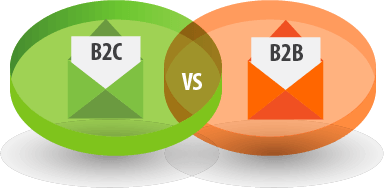The boundaries between B2C and B2B email deliverability often overlap. Someone might give their personal email when they fill out a form to get a business-flavored white paper; someone else might give their business email address when they buy perfume online while they’re at work.
But the boundaries between B2C and B2B deliverability are a bit more complicated. It’s harder to get your B2B email into the inbox, and here’s why.
Domains – What type of inbox are you sending to?
When we talk about “domain” in this context, we’re talking about the part of an email address that follows the “@” symbol. When it comes to an area as narrow and specialized as deliverability, it’s good to understand the differences between the type of business and the type of inbox.
We often assume that [email protected] is a consumer email address, and so potentially a B2C customer. And [email protected] looks like a business address, and potentially a B2B customer. But that’s not always the case. Along with people blurring their personal and business activities, we’ve all seen small businesses sending us emails from a B2C domain such as Gmail.com or Yahoo.com ([email protected]). And a small business may use an alias that makes it look like they are sending from their own dedicated email server ([email protected]). The type of business is not always equivalent to the type of inbox.
Think domain when it comes to delivery
One way to think of the differences between the B2C and the B2B email recipient is to define them by the nature of the filtering they use.
The B2B mailbox
A B2B mailbox is maintained by the user or organization. They have the ability to customize the filtering settings and employ additional corporate or commercial filters.
Most B2B businesses these days who have their own B2B mailboxes employ commercial filtering applications (such as Proofpoint and Cloudmark) and public blocklists (such as Spamhaus and SpamCop) on top of the possible private blocklists and client-based filtering applications that are already in place. They do this to protect their employees, their privacy, their intellectual property, and to increase productivity. If your emails are being blocked by them, they may not make it easy to get such a block lifted.
The B2C mailbox
A B2C mailbox, on the other hand, is completely subject to the unified filtering algorithms defined by the mailbox provider. The end user may set up some additional filters in their email client, but these are small and infrequent compared to the provider’s actions.
While B2C mailbox providers never disclose their spam filtering algorithms, blocklists, or reputation systems, they have clear and transparent policies on bulk sending and in some cases instructions on how you can get a block removed. I wouldn’t say these things necessarily make B2C domain deliverability easier, but there are certainly many fewer variables you have to deal with compared to a B2B environment, where virtually everything is customizable.
Another thing that’s noteworthy is that some major B2C Internet service providers (such as Gmail) have a large commercial customer base that uses their B2B mailbox services. In this situation, there is a tendency for B2C and B2B email delivery to converge and share the same filters.
Think business when it comes to deliverability
So, does the type of business still matter now that we know the domain is the main factor that comes into play in email delivery? The answer is a clear yes, because “delivered” does not necessarily mean your email is delivered to the recipient’s inbox. And worrying about your inbox placement without knowing whether the ISP has accepted your email first is rather putting the cart before the horse.
Once an email has been delivered, the focus shifts from the domain to the business. Whether the business is B2B or B2C, there has been a general consensus that positive engagement data such as opening, moving (foldering or archiving, not junking) and replying to an email plays an increasingly important role in determining email placement. In practice, this means that you should make sure that what you are sending (and when, if possible) is optimized for the recipients and their businesses so as to achieve maximum engagement and deliverability. Send messages people will value and want to open, and the ISPs will notice and reward you with better deliverability (assuming your other practices, such as list hygiene, are up to snuff).
Mobile
The gap between B2B vs. B2C engagement behaviors is also merging a bit thanks to the rise in mobile email usage. People tend to prioritize mentally more on mobile, and if you’re lucky – make that if you’re meaningful – they may save your mobile message to be read on a larger screen. For more tips on how to optimize your emails for mobile and generate leads, check out our eBook, “The Amazingly Effective Email Marketing Automation Guide.”
The takeaway
The road between the marketer and the B2B inbox is bumpier than the road to the B2C inbox, and sometimes the two types of messages will jostle for attention in the same place. Make sure your message, no matter what it is, is relevant to the reader, and that your headline makes a promise that your message fulfills.

